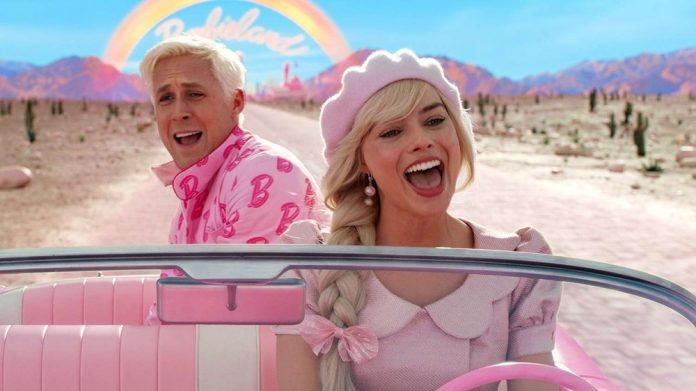Let’s start with what Greta Gerwig’s Barbie is not. If your expectation going into Barbie is that it will be some live-action version of the saccharine Barbie animated videos that are G-rated and aimed at young kids… this is not that movie. What the film is, though, is something far better — a charming, unexpectedly subversive Barbie movie made for adults, in particular for adult women who, like me, grew up playing endlessly with our collection of Barbie dolls (and maybe a token Ken doll), making up our own weird and not-always-so-G-rated storylines, trying to make sense of the adult world while emulating ideas of what being an adult might feel like through the stories we’d act out with our dolls.
Gerwig, who started out acting in Mumblecore films, first came to serious notice as a writer and director with her 2017 film Lady Bird, which garnered solid reviews and grossed a respectable $78 million worldwide, followed by her adaptation of Little Women, which hit over $218 million worldwide. I call this out to note that Gerwig has had an impressive trajectory leading up to tackling Barbie, which makes it somewhat less surprising that Mattel and Warner Bros. greenlit a Barbie movie like this, trusting Gerwig to handle their beloved brand respectfully, with a script that simultaneously challenges some of the very things that the Barbie brand represents.
In Gerwig’s Barbie Land, the Barbies rule, and the Kens are merely arm candy. All the Barbies have Dream Houses, Corvettes, RVs, and designer fashions — all the marvelous things in the Barbie world that we grew up playing with — and the meticulous artistic direction by production designer Sarah Greenwood is fascinating in its attention to every single little detail. It would be easy enough to breeze through the nearly-two-hour running time doing nothing but marveling over the minutiae so precisely nailed in this production, being flooded with warm nostalgia surrounding things like the milk carton, the sunglasses, and the detailing on every outfit and aspect of Barbie Land.
Life sure is perfect in Barbie Land, as we see through a glorious opening sequence that settles us into this world. Here, Barbie is the President and all the members of the Supreme Court. She’s a surgeon, an architect, a gymnast, a surfer, and a fashionista, too. Every Barbie has her own Dream House right next to the other Dream Houses, so the Barbies can all wave at each other and say “Good morning.” In Barbie Land, every Barbie is everything she wants to be, her fabulous outfits magically appear on her, her toast is never burnt, and she doesn’t even use water to take a shower.
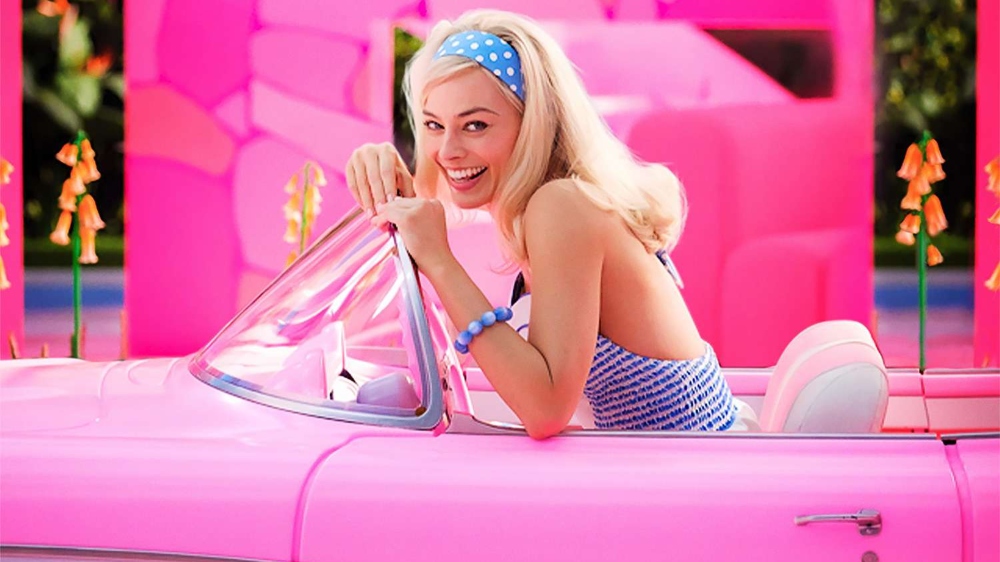
The Barbies like to hang out with each other, but they also have their Kens who, as Ryan Gosling‘s Ken says early in the film, only exist “within the warmth of Barbie’s gaze.” Gosling’s Ken has a vague job (“beach”), which he desperately wants to do very well in order to impress Barbie and a rival Ken (Simu Liu) who has better dance moves. He’s not allowed to stay the night when Barbie has sleepover parties because it’s Barbie’s Dream House, not Barbie and Ken’s Dream House. But still, all is just perfect in Barbie Land. Or is it? If the way Gerwig flips the relationships between men and women in Barbie Land makes you uncomfortable, that’s very much intentional.
One day, Stereotypical Barbie (Margot Robbie, who also produced this Warner Bros. release) starts having dark thoughts, asking other Barbies at a party, “Do you ever think about dying?” She’s changing, and the physics of Barbie Land stop working for her. Her quest to understand what’s going on in her head leads her to Weird Barbie (Kate McKinnon), who we learn has been played with “too hard” by her child, as her hair has been chopped off at weird angles and her face is adorned with marker tattoos. Weird Barbie tells Barbie that she needs to go to the Real World and find the girl who’s playing with her, to connect with her and resolve these issues and get things back to “normal.”
Without revealing too much of the plot from there, suffice it to say that Barbie makes this journey and Ken (Gosling) comes along for the ride to the Real World, because he’s Barbie’s boyfriend, kind of, and he can’t imagine being without her.
Once in the Real World, both Barbie and Ken have their world-views turned inside-out; Barbie, by realizing that the female-empowered world of Barbie Land has not actually influenced and shaped the Real World in the way she believed it had, and Ken by being exposed to a patriarchy and misogyny that challenge his perspective on life in Barbie Land, where Barbie is “everything” and Ken is “just Ken.” Out in the Real World, Barbie connects with her girl, Sasha (Ariana Greenblatt), a surly teen, and Sasha’s mom, Gloria (America Ferrera), and together they set out to fix things.
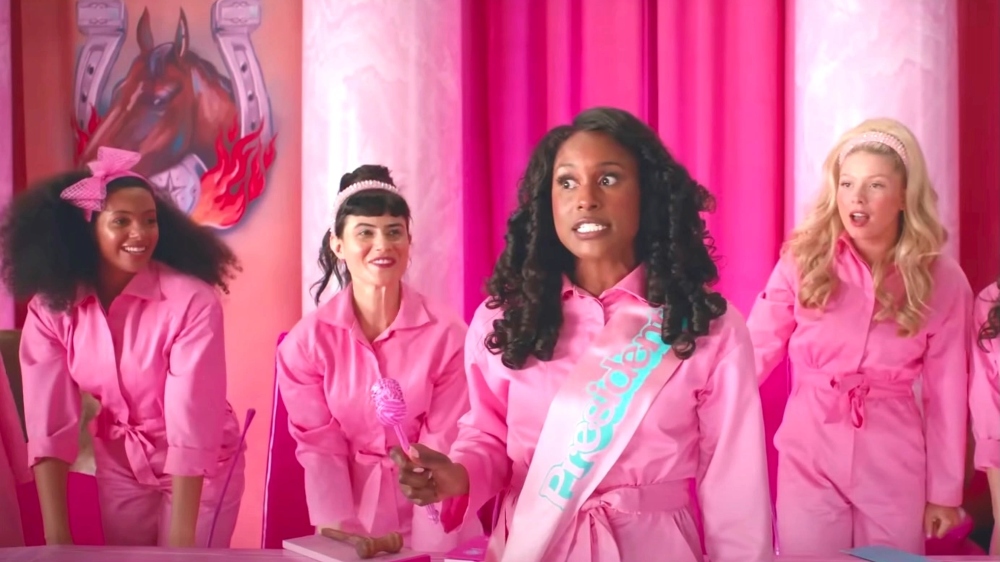
Gerwig’s take on the world of Barbie in the script is undeniably subversive, boldly challenging stereotypes about what Barbie represents and who she is. At the same time, the artistic world Gerwig creates for this film is obsessive in its attention to all the tiny, seemingly mundane details of the Barbie brand that will have the adult women in the audience rapt with nostalgia. Most impressively, Gerwig seamlessly interweaves criticisms about Barbie dolls with all the cool and independent aspects of being Barbie. Meanwhile, Gloria and Sasha serve as our Real World stand-ins who grapple with the realities that real women often face, as Gloria struggles with being noticed in her low-level job and Sasha deals with the challenges of being a teenage girl on the brink of adulthood.
So how does this all come together as a movie, and who is this movie for?
The marketing of Barbie has leaned heavily on not giving away much of the plot, and on wowing the audience with the production design, the Barbie brand, and its starry cast — particularly the idea of Robbie and Gosling as Barbie and Ken. The movie has all those things, but for me, the way the film has been marketed is somewhat misleading to families with younger kids who are going to want to see this movie just because they immediately love all things branded Barbie. This isn’t a G-rated animated Barbie film with a simple plot and ideas, it’s a richly complex take on Barbie as a brand and its deeper impact on society, told through Barbie brought to life. The PG-13 rating should serve as a bit of a warning; the storyline and dialogue reference some sexual things like genitalia and virginity, and there’s some language some parents may also find objectionable. These aspects of Barbie the movie haven’t been particularly clear from the marketing blasts, which have more centered on the colorful production design, the novelty of Ryan Gosling as Ken, and Robbie showcasing meticulous reproductions of some of Barbie’s more noteworthy outfits.
The Toy Story films managed to walk a line between “kid-friendly” and “nostalgic and interesting for adults,” but Barbie feels like more of a film made for adults that kids may also come to. Parents planning to see Barbie with pre-teen daughters may want to be aware going in that this movie is not going to feel like the made-for-video movies of their previous Barbie viewing experiences, but something deeper, more challenging, and which addresses some adult concepts and issues that they should be prepared to explain to younger kids.
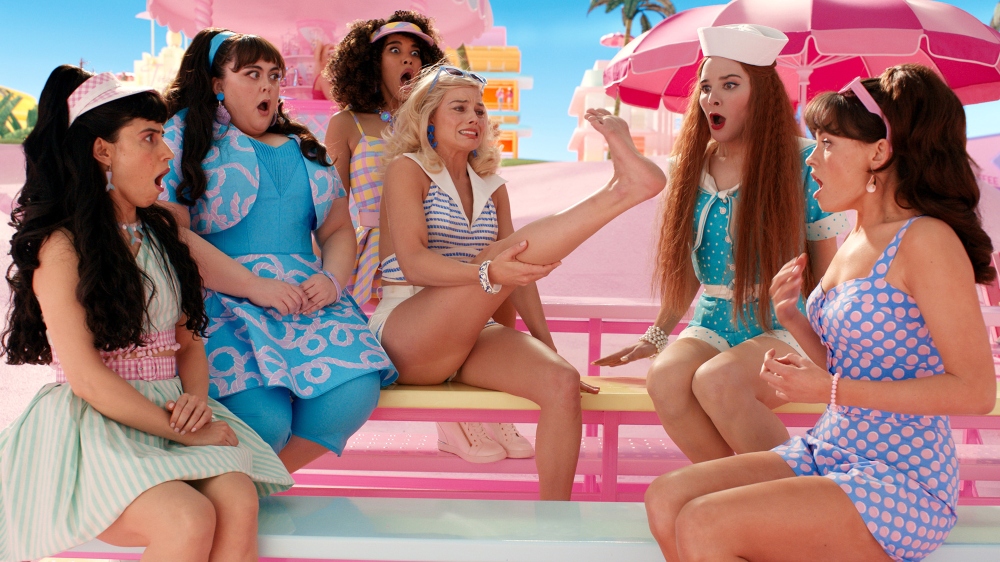
As an adult woman who grew up with Barbies being a defining part of my own girlhood and self-identity, who both loved Barbies for their sense of empowerment, female independence and fashion while hating, retrospectively, how Barbie’s unrealistic proportions made me view my own body and informed my sense of what being “female” means, I loved so many aspects of this film, from the production design and costumes to the performances and the societal ideas Gerwig challenges in this story.
Barbie’s “awakening” via her connection to the human playing with her and the dark thoughts they’re having is a clever way to bring together Barbie Land and the Real World, where these ideas can be drawn out and explored. Are Barbie dolls good for girls, or bad? Empowering or demeaning? What does “power” mean in our relationships? And what might happen if a group that’s been disempowered discovers that there are other social models to adopt and work from?
Gerwig challenges ideas around patriarchy and female independence and especially those concerning the relationship and power struggle between men and women in a way that feels absolutely intentional. She challenges traditional structures through the vehicle of a beloved brand whose broader appeal crosses political lines, and some folks are simply not going to like the way in which Gerwig presents these ideas, which is completely okay. Ideas that challenge us and make us question our belief systems are still useful as they force us to understand how those ideas “fit” within the construct of our own real worlds.
These conflicts in Barbie are challenged via the contrast between Barbie Land, where Barbie is strong, powerful, in charge, and capable of doing anything, with a Real World rooted in patriarchy and misogyny. Gerwig also challenges the “Barbie” standard of beauty; in her Barbie Land, Barbie has all different skin colors and body types; I loved that some of the discontinued Barbies like Happy Family Pregnant Midge (Emerald Fennell) and Allan (Michael Cera) have a place in this world, too. As an aside, Allan was one of my favorite characters in this film. He doesn’t really fit in with the other Kens and is a bit of a lonely social outcast, but Cera’s performance is so spot-on that it’s hard to imagine another actor in that role.
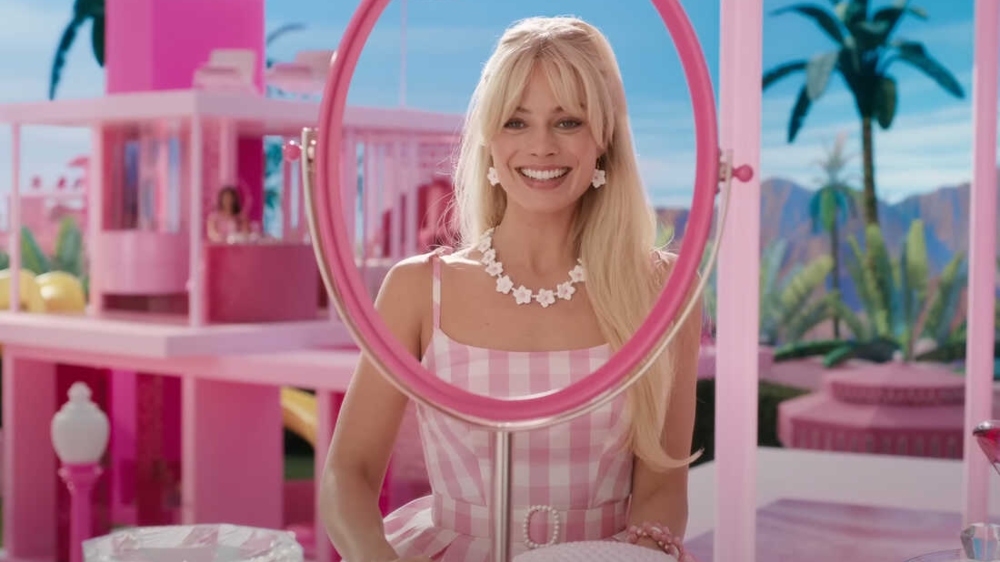
The cast and crew of this film are packed with award-winning talent, and it shows in the quality of the acting across the board. Robbie looks the part of classic, blonde Barbie while bringing a seriousness to the role that makes the character so much more than just a doll brought to life. She’s not just dialing in a fun, light performance showcasing the Barbie “brand” here, but using her Barbie as a metaphor for Gerwig to explore some weightier ideas about power and what it means. Gosling is just terrific in his portrayal of Ken, by turns unselfconsciously, hilariously goofy, and then serious and thoughtful, using Ken’s exposure to the Real World to flip the character’s naivete on its ear. Will Ferrell deserves a special mention for his hilarious portrayal of the character known only as “Mattel CEO,” whose presence here (along with a slew of junior execs) demonstrates that someone over at Mattel has a sense of humor.
As an adult who grew up on Barbie, I really loved Gerwig’s approach to telling this story in a way that raises as many questions as it answers and challenges its audience to really digest this movie and its themes, whether they love it or hate it. Essentially, by using subversion as a key element of the Barbie movie, Gerwig pulls the idea of Barbie and what she represents into our own real world, where the social constructs being challenged by the film can be absorbed, discussed, and reflected on.
Even if you didn’t grow up playing with Barbies and loving the brand, there’s an exploration of ideas here worth checking out. If my own kids were still pre-teens, I’d take them to see Barbie, and we’d have a great conversation after. But I’d probably also want to catch it again just with my adult women friends, who’d appreciate it on a whole different level. This isn’t quite the Barbie movie you imagined in your childhood, perhaps, but it’s thoroughly enjoyable, funny, nostalgic, and smart all at the same time, making Gerwig’s Barbie Land well worth a visit.
Barbie is now playing in theaters worldwide courtesy of Warner Bros. and Mattel.


